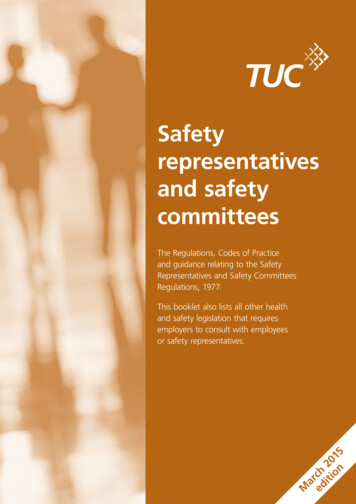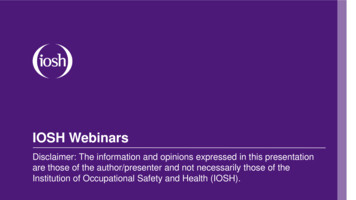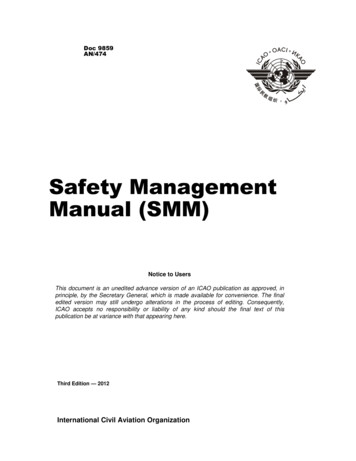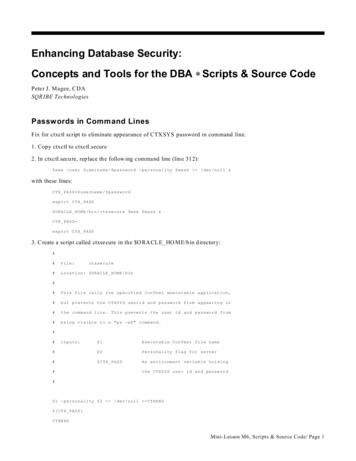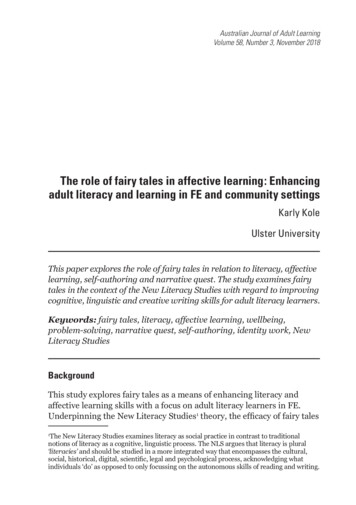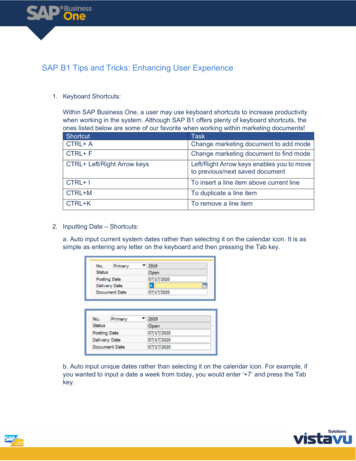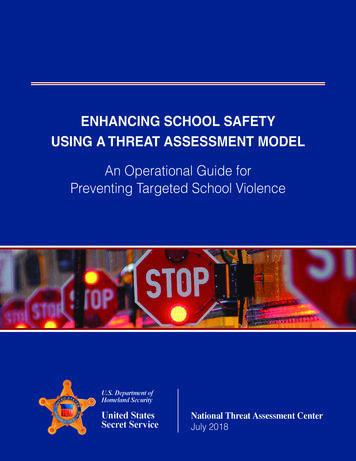
Transcription
ENHANCING SCHOOL SAFETYUSING A THREAT ASSESSMENT MODELAn Operational Guide forPreventing Targeted School ViolenceNational Threat Assessment CenterJuly 2018
UNITED STATES SECRET SERVICEThis guide was prepared by the staff of theU.S. Secret Service National Threat Assessment Center (NTAC)Lina Alathari, Ph.D.ChiefDiana Drysdale, M.A.Lead Social Science Research SpecialistAshley Blair, M.A.Social Science Research SpecialistJeffrey McGarry, M.A.Social Science Research SpecialistCatherine Camilletti, Ph.D.Social Science Research SpecialistAmanda Snook, Ph.D.Social Science Research SpecialistSteven Driscoll, M.Ed.Social Science Research SpecialistNational Threat Assessment CenterU.S. Secret ServiceU.S. Department of Homeland SecurityJuly 2018This publication is in the public domain. Authorization to copy and distribute thispublication in whole or in part is granted. However, the U.S. Secret Service star insigniamay not be used in any other manner without advance written permission from theagency. While permission to reprint this publication is not necessary, when quoting,paraphrasing, or otherwise referring to this report, the citation should be: National ThreatAssessment Center. (2018). Enhancing school safety using a threat assessment model:An operational guide for preventing targeted school violence. U.S. Secret Service,Department of Homeland Security.Enhancing School Safety Using a Threat Assessment Model An Operational Guide for Preventing Targeted School Violence
CONTENTSMESSAGE FROM THE DIRECTOR . . . . . . . . . . . . . . . . . . . . . . . . . . IVINTRODUCTION . . . . . . . . . . . . . . . . . . . . . . . . . . . . . . . . . . . 1CREATING A COMPREHENSIVE TARGETED VIOLENCE PREVENTION PLAN . . 2Step 1.Step 2.Step 3.Step 4.Step 5.Establish a multidisciplinary threat assessment team. . . .Defne concerning and prohibited behaviors. . . . . . . .Create a central reporting mechanism. . . . . . . . . . .Determine the threshold for law enforcement intervention.Establish assessment procedures. . . . . . . . . . . . . .Investigative Themes:Motives . . . . . . . . . . . . . . . . . . . . . . . . . .Communications . . . . . . . . . . . . . . . . . . . . .Inappropriate interests . . . . . . . . . . . . . . . . . .Weapons access. . . . . . . . . . . . . . . . . . . . .Stressors . . . . . . . . . . . . . . . . . . . . . . . . .Emotional and developmental issues . . . . . . . . . .Desperation or despair . . . . . . . . . . . . . . . . .Violence as an option . . . . . . . . . . . . . . . . . .Concerned others . . . . . . . . . . . . . . . . . . . .Capacity to carry out an attack . . . . . . . . . . . . .Planning . . . . . . . . . . . . . . . . . . . . . . . . .Consistency . . . . . . . . . . . . . . . . . . . . . . .Protective factors. . . . . . . . . . . . . . . . . . . . .Step 6. Develop risk management options. . . . . . . . . . . . .Step 7. Create and promote safe school climates. . . . . . . . . .Step 8. Conduct training for all stakeholders. . . . . . . . . . . .34567.9. 10. 11. 11. 12. 13. 13. 14. 14. 15. 15. 16. 16. 17. 19. 21CONCLUSION . . . . . . . . . . . . . . . . . . . . . . . . . . . . . . . . . . . .23ADDITIONAL RESOURCES FOR SCHOOLS . . . . . . . . . . . . . . . . . . . .24Threat assessment . . . . . . . . . . . . . . . . . . . . . .School safety and violence prevention . . . . . . . . . . .Emergency management and response to school violenceCreating safe and positive school climates. . . . . . . . .Prevention and intervention of bullying . . . . . . . . . . .Mental health. . . . . . . . . . . . . . . . . . . . . . . . . 24. 25. 26. 26. 27. 27
UNITED STATES SECRET SERVICEMESSAGE FROM THE DIRECTORSince the creation of the U.S. Secret Service in 1865, theagency has evolved to meet changing mission demandsand growing threats in our nation. To ensure we remainon the forefront, the U.S. Secret Service’s National ThreatAssessment Center (NTAC) was created in 1998 to provideguidance and training on threat assessment both withinthe U.S. Secret Service and to others with criminal justiceand public safety responsibilities. Today, the highly skilledmen and women of the U. S. Secret Service lead the feldof threat assessment by conducting research on acts oftargeted violence and providing training using the agency’sestablished threat assessment model for prevention.have redoubled our efforts and are poised to continueenhancing school safety. Keeping our school children saferequires the shared commitment from states, school boards,and communities with the ability to dedicate resourcesto this critical issue. In the wake of these tragedies, theU.S. Secret Service has launched an initiative to provideupdated research and guidance to school personnel,law enforcement, and other public safety partners on theprevention of school-based violence. I am pleased torelease this operational guide, Enhancing School SafetyUsing a Threat Assessment Model, as the frst phase of thisinitiative.Our agency is dedicated to expanding research andunderstanding of targeted violence, including those thatimpact our nation’s schools. Since the creation of the U.S.Secret Service’s NTAC, we have provided 450 in-depthtrainings on the prevention of targeted school violence toover 93,000 attendees including school administrators,teachers, counselors, mental health professionals, schoolresource offcers, and other public safety partners. Ouragency, through our local U.S. Secret Service feld offces,continues to coordinate and provide this training to ourcommunity partners.As we have seen in recent months, the pain of each actof targeted violence in our nation’s schools has had apowerful impact on all. With the creation and distribution ofthis operational guide, the U.S. Secret Service sets a pathforward for sustainable practices to keep our children safe,extending our expertise in the feld of threat assessmentsto provide school offcials, law enforcement personnel, andother public safety professionals with guidance on “howto” create a Targeted Violence Prevention Plan. This guidewill serve as an important contribution to our partners onthe Federal Commission on School Safety - the Departmentof Homeland Security, the Department of Education, theDepartment of Health and Human Services and the Offceof the Attorney General. I am proud of the continued effortsof the U.S. Secret Service, and we remain committed to theprevention of targeted violence within our nation’s schoolsand communities.The tragic events of the February 14, 2018 shooting atMarjory Stoneman Douglas High School in Parkland, Florida,and the May 18, 2018 shooting at Santa Fe High School inSanta Fe, Texas, demonstrated the ongoing need to provideleadership in preventing future school attacks. As such,the U.S. Secret Service, along with many of our partners,Randolph D. AllesDirectorEnhancing School Safety Using a Threat Assessment Model An Operational Guide for Preventing Targeted School ViolenceIV
INTRODUCTIONWhen incidents of school violence occur, they leave aprofound and lasting impact on the school, the community,and our nation as a whole. Ensuring safe environmentsfor elementary and secondary school students, educators,administrators, and others is essential. This operationalguide was developed to provide fundamental direction onhow to prevent incidents of targeted school violence, that is,when a student specifcally selects a school or a member ofthe school community for harm. The content in this guide isbased on information developed by the U.S. Secret Service,Protective Intelligence and Assessment Division, NationalThreat Assessment Center (NTAC).Over the last 20 years, NTAC has conducted research,training, and consultation on threat assessment and theprevention of various forms of targeted violence. Followingthe tragedy at Columbine High School in April 1999, theSecret Service partnered with the Department of Educationon a study that examined 37 incidents of targeted violencethat occurred at elementary and secondary schools (i.e.,K-12). The goal of that study, the Safe School Initiative(SSI), was to gather and analyze accurate and usefulinformation about the thinking and behavior of students whocommit these types of acts. The fndings of the SSI, and anaccompanying guide, served as the impetus for establishingthreat assessment programs in schools. In 2008, theagencies collaborated again and released a report thatfurther explored one of the key SSI fndings, namely, thatprior to most attacks, though other students had informationabout the attackers’ plans, most did not report theirconcerns to an adult. The fndings of this report, known asthe Bystander Study, highlighted the importance of creatingsafe school climates to increase the likelihood that studentswill speak up in order to prevent an attack.11“ There is noprofle ofa studentattacker. ”The information gleaned from these studies underscoresthe importance of establishing a threat assessmentprocess in schools to enhance proactive targeted violenceprevention efforts. The goal of a threat assessmentis to identify students of concern, assess their risk forengaging in violence or other harmful activities, andidentify intervention strategies to manage that risk. Thisguide provides actionable steps that schools can take todevelop a comprehensive targeted violence preventionplan and create processes and procedures for conductingthreat assessments on their campus. These steps serveas minimum guidelines and may need to be adaptedfor a particular school or district’s unique resources andchallenges. For institutions that already have preventionplans or threat assessment capabilities in place, theseguidelines may provide additional information to updateexisting protocols, or to formalize the structures of reporting,gathering information, and managing risk.When establishing threat assessment capabilities withinK-12 schools, keep in mind that there is no profle ofa student attacker. There have been male and femaleattackers, high-achieving students with good grades as wellas poor performers. These acts of violence were committedby students who were loners and socially isolated, andthose who were well-liked and popular. Rather thanfocusing solely on a student’s personality traits or schoolperformance, we can learn much more about a student’srisk for violence by working through the threat assessmentprocess, which is designed to gather the most relevantinformation about the student’s communications andbehaviors, the negative or stressful events the student hasexperienced, and the resources the student possesses toovercome those setbacks and challenges.All publications related to studies conducted by the U.S. Secret Service, National Threat Assessment Center (NTAC) are available .1
UNITED STATES SECRET SERVICECREATING A COMPREHENSIVE TARGETEDVIOLENCE PREVENTION PLANEnsuring the safety of our schools involves multiplecomponents, including physical security, emergencymanagement, and violence prevention efforts in the formof a threat assessment process. This process begins withestablishing a comprehensive targeted violence preventionplan. The plan includes forming a multidisciplinarythreat assessment team, establishing central reportingmechanisms, identifying behaviors of concern, defning thethreshold for law enforcement intervention, identifying riskmanagement strategies, promoting safe school climates,and providing training to stakeholders. It can also helpschools mitigate threats from a variety of individuals,including students, employees, or parents.This guide provides basic instructions for schools oncreating a targeted violence prevention plan, the focusof which is to decrease the risk of students engagingin harm to themselves or the school community. Theserecommendations serve as the starting point on a pathto implementation that will need to be customized to thespecifc needs of your school, your student body, and yourcommunity. When creating these plans, schools shouldconsult with legal representatives to ensure that they complywith any applicable state and federal laws or regulations.Enhancing School Safety Using a Threat Assessment Model An Operational Guide for Preventing Targeted School Violence2
Step 1.Establish a multidisciplinary threat assessment team“ .meet ona regularbasis. ”The frst step in developing a comprehensive targeted violence prevention plan is toestablish a multidisciplinary threat assessment team (hereafter referred to as the “Team”)of individuals who will direct, manage, and document the threat assessment process.The Team will receive reports about concerning students and situations, gather additionalinformation, assess the risk posed to the school community, and develop intervention andmanagement strategies to mitigate any risk of harm. Some considerations for establishinga Team include: Some schools may pool their resources and have a single Team that servesan entire district or county, while other districts may choose to have aseparate Team for each school. Teams should include personnel from a variety of disciplines within theschool community, including teachers, guidance counselors, coaches,school resource offcers, mental health professionals, and schooladministrators. The multidisciplinary nature of the Team ensures thatvarying points of view will be represented and that access to informationand resources will be broad. The Team needs to have a specifcally designated leader. This position isusually occupied by a senior administrator within the school. Teams should establish protocols and procedures that are followed foreach assessment, including who will interview the student of concern; whowill talk to classmates, teachers, or parents; and who will be responsible fordocumenting the Team’s efforts. Established protocols allow for a smootherassessment process as Team members will be aware of their own roles andresponsibilities, as well as those of their colleagues. Team members should meet whenever a concerning student or situationhas been brought to their attention, but they should also meet on a regularbasis to engage in discussions, role-playing scenarios, and other teambuilding and learning activities. This will provide members of the Team withopportunities to work together and learn their individual responsibilities sothat when a crisis does arise, the Team will be able to operate more easilyas a cohesive unit.3While the information in thisguide refers to this groupas a Threat AssessmentTeam, schools can choosean alternative name. Forexample, some schoolshave opted to use thelabel “Assessment andCare Team” to encourageinvolvement from those whomight be concerned abouta student, and to focus ongetting a student accessto needed resources andsupports. Other schoolshave chosen to refer tothis group as a “BehavioralIntervention Team” tofocus on a spectrum ofconcerning behaviorsthat a student may beexhibiting. Finally, someschools have continuedto refer to their groups as“Threat Assessment Teams”to highlight the heightenedsense of concern about astudent who is identifed.
UNITED STATES SECRET SERVICEStep 2.Defne prohibited and concerning behaviorsSchools need to establish policies defning prohibitedbehaviors that are unacceptable and therefore warrantimmediate intervention. These include threatening orengaging in violence, bringing a weapon to school, bullyingor harassing others, and other concerning or criminalbehaviors. Keep in mind that concerning behaviors occuralong a continuum. School policies should also identifybehaviors that may not necessarily be indicative of violence,but also warrant some type of intervention. These includea marked decline in performance; increased absenteeism;withdrawal or isolation; sudden or dramatic changes inbehavior or appearance; drug or alcohol use; and erratic,depressive, and other emotional or mental health symptoms. If these behaviors are observed or reported to the Team,schools can offer resources and supports in the form ofmentoring and counseling, mental health care, tutoring, orsocial and family services. The threshold for intervention should be relatively lowso that Teams can identify students in distress before theirbehavior escalates to the point that classmates, teachers,or parents are concerned about their safety or the safetyof others. It is much easier to intervene when the concernis related to a student’s struggle to overcome personalsetbacks, such as a romantic breakup, than when thereare concerns about threats posed to others. During the assessment process, Teams may identifyother concerning statements and actions made bythe student that may not already be addressed in theirpolicies. Gathering information about these behaviorswill help the Team assess whether the student is at risk forattacking the school or its students and identify strategiesto mitigate that risk.Enhancing School Safety Using a Threat Assessment Model An Operational Guide for Preventing Targeted School Violence4
CREATING A COMPREHENSIVE TARGETED VIOLENCE PREVENTION PLANStep 3.Create a central reporting mechanismStudents may elicit concern from those around them in avariety of ways. They may make threatening or concerningstatements in person, online, or in text messages; they mayengage in observable risky behavior; or they may turn inassignments with statements or content that is unusual orbizarre. When this occurs, those around the student need amethod of reporting their concerns to the Team. Schools can establish one or more reportingmechanisms, such as an online form posted on theschool website, a dedicated email address or phonenumber, smart phone application platforms, or anothermechanism that is accessible for a particular schoolcommunity. Students, teachers, staff, school resource offcers, andparents should be provided training and guidance onrecognizing behaviors of concern, their roles andresponsibilities in reporting the behavior, and how toreport the information. Teams need to be sure that a team member proactivelymonitors all incoming reports and can respondimmediately when someone’s safety is concerned. Regardless of what method schools choose to receivethese reports, there should be an option for passinginformation anonymously, as students are more likely toreport concerning or threatening information when theycan do so without fear of retribution for coming forward. The school community should feel confdent that teammembers will be responsive to their concerns, and thatreports will be acted upon, kept confdential, andhandled appropriately.5“ .reports willbe actedupon.”Many reportingmechanisms employedby K-12 schools resemblenationwide criminalreporting apps. The onlineand phone reportingcapabilities of these typesof apps allow individualsacross the country,including students,parents, and teachers, toreport crimes and otherconcerning behaviorsin their communitiesand schools. Somereporting mechanisms aredeveloped specifcally foruse by students in
on the forefront, the U.S. Secret Service's National Threat Assessment Center (NTAC) was created in 1998 to provide guidance and training on threat assessment both within the U.S. Secret Service and to others with criminal justice and public safety responsibilities. Today, the highly skilled men and women of the U. S. Secret Service lead the feld



